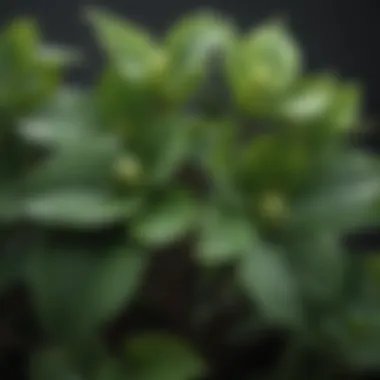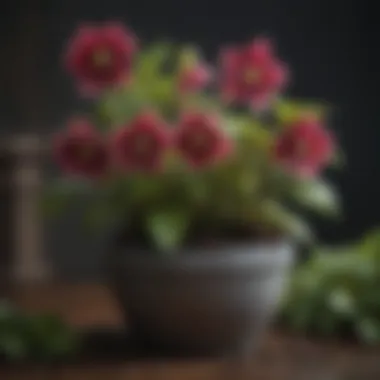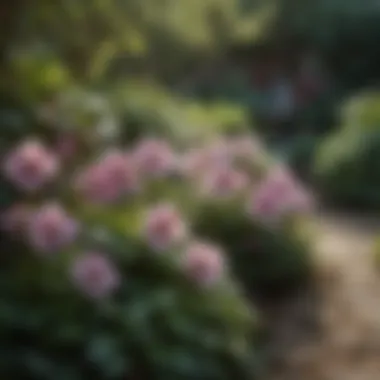The Ultimate Guide to Purchasing Hellebore Plants


Intro
Hellebores are captivating plants, known for their elegance and early bloom times. As a homeowner or gardening enthusiast, delving into the world of hellebores can significantly enrich your garden. This guide provides detailed insights into selecting, cultivating, and appreciating these unique plants.
Hellebores, often called the winter rose, are resilient perennials that thrive in various conditions, making them a desirable addition for many gardeners. Understanding their specific requirements can enable you to create stunning displays in your outdoor spaces. From comprehending the varieties available to exploring their cultivation needs, this guide aims to equip you with knowledge and practical advice.
Gardening Know-How
Plant Care Guides
Caring for hellebores involves understanding their basic needs. These plants prefer well-drained soil rich in organic matter. Regular watering is essential but avoid waterlogging, as it can damage roots. After the blooms fade, it's important to prune back the foliage. This encourages new growth and maintains a neat appearance. Regularly assess the condition of the leaves and remove any that appear diseased.
Seasonal Gardening Tips
Hellebores bloom from late winter to early spring, often when other plants are still dormant. Illustrating their versatility, they flourish in semi-shade or even shade conditions. For optimal growth, plant them in a sheltered location to protect from harsh winds. Fertilizing should occur annually in late winter, using a balanced fertilizer to support robust foliage and abundant blossoms. Know that hellebores may take a few years to reach their full potential, thus, patience is vital.
DIY Garden Projects
Creating your dream hellebore display can become a rewarding project. Consider grouping different varieties for added visual appeal. Mixing hellebores with early-flowering bulbs, like daffodils or crocuses, can enhance your garden’s dynamism. A creative idea is to plant hellebores in decorative pots or raised beds, making it easier to monitor growth and care needs. Incorporating stones or mulch around the plants can control weeds and conserve moisture.
Hellebores are not just plants; they embody resilience and unique beauty, enhancing the gardening experience through their seasonal charms.
Assess whether your garden's aesthetics can benefit from added structure. For instance, surrounding hellebores with low-growing evergreen plants creates contrast throughout the year, presenting interest even during off-seasons.
When sourcing hellebores, consider local nurseries specializt in native plants. They often offer healthy, well-cared-for specimens. Online retails, like Burpee and GrowJoy, also provide a range of choices but do inquire about their growing conditions to ensure compatibility with your garden.
Understanding Hellebores
Understanding hellebores is essential for anyone looking to cultivate these unique plants. Hellebores are known for their ability to bloom in early spring, defying the winter chill. This makes them an attractive choice for gardeners wanting early color in their landscapes. Familiarity with hellebores will help one appreciate variations in species and adapt choices to different environmental conditions.
What Are Hellebores?
Hellebores are perennial plants belonging to the family Ranunculaceae. They are also known as Lenten roses, a name that references their traditional spring flowering period, which coincides with the Christian season of Lent. Native primarily to Europe and Asia, hellebores display a delightful array of flowers that can be understated or striking, depending on the variety. With a variety of colors, petal shapes, and growth patterns, hellebores can suit various garden styles.
History and Origins of Hellebores
Hellebores have been revered since ancient times, often mentioned in historical texts and folklore. Their earliest cultivation dates back to antiquity, with records indicating they were often associated with medicinal properties. The Greeks and Romans believed certain species could treat ailments, which sparked interest among early herbalists. Over time, selective breeding led to many hybrids, broadening their appeal and utility in modern gardens. Various cultures throughout history have valued these plants not just for their beauty but for their symbolic significance as harbingers of spring.
Common Varieties of Hellebores
Many hellebore varieties exist, each with distinct characteristics. Some popular types include:
- Helleborus niger: Known as the Christmas rose, it features white flowers that can appear even under snow.
- Helleborus orientalis: Also known as Lenten rose, this type exhibits numerous color variations, ranging from purples to pinks.
- Helleborus foetidus: The stinking hellebore is notable for its attractive green flowers.
By understanding these varieties, gardeners can make informed plants' choices that reflect their aesthetic desires and ecological needs. Each type has unique growth habits and care requirements, underscoring the importance of selecting the right one for your garden setting.
Growing Conditions for Hellebores
Understanding the growing conditions for hellebores is critical to maximizing their health and vibrancy. Hellebores are delicate yet resilient plants that thrive when aligned with their natural preferences. Recognizing the significance of soil types, light exposure, and watering frequency will ensure that your plants not only survive but also flourish in their garden setting.
Preferred Soil Types
Soil plays a crucial role in the well-being of hellebores. As perennial plants, they benefit from well-drained, rich soil that is high in organic matter. The following factors contribute to suitable soil conditions:
- pH Levels: Hellebores prefer slightly acidic to neutral pH levels, ideally between 6.0 and 7.0. If your soil is overly alkaline, consider adding sulfur or peat moss to increase acidity.
- Drainage: Good drainage is vital to prevent root rot. Soil that remains too wet can seriously affect hellebore health. Improving drainage can be achieved by incorporating materials like compost or sand.
- Nutrient Content: Nutrient-rich soils promote stronger growth. Before planting, it is wise to enrich the soil with well-rotted compost or aged manure, providing a good nutrient balance for your hellebores.


Light Requirements
Light is another key element influencing the growth of hellebores. Although these plants might display resilience to less favorable lighting, they have specific preferences that optimize their flowering and overall vigor:
- Shade Preference: Hellebores typically flourish in partial shade, thriving under dappled sunlight. They can tolerate some direct sunlight, particularly in cooler climates.
- Morning Sun: Exposure to morning sun can be beneficial as it helps dry out dew on the leaves. Avoid locations that expose them to harsh afternoon sun to reduce the risk of leaf scorch.
- Location Planning: When positioning hellebores in your garden, pay attention to overhead light sources such as trees. Watch out for too much cover that can hinder their growth due to insufficient light.
Watering Needs
When cultivating hellebores, proper watering practices are essential. Correct moisture levels promote robust root systems and encourage healthy blooms:
- Consistent Moisture: Hellebores thrive in consistently moist (but not soggy) soil. During hot, dry spells, an increase in water intake is often needed. Using a mulch layer can assist with moisture retention.
- Water Quality: Ideally, use rainwater that is free from chemicals found in tap water. However, standard tap water is often acceptable if it’s not overly chlorinated.
- Avoid Overwatering: Adjust watering according to weather conditions. During cool, damp periods, reduce the frequency to prevent unsuitable moisture conditions.
Remember, each variety of hellebore may have unique preferences. Understanding these differences will bolster your gardening success.
By establishing suitable growing conditions, you are setting a thriving stage for your hellebores. Healthy soil, appropriate lighting, and consistent watering will deliver the resources these plants need for robust growth. The foresight in providing these specific environmental factors aids in creating a stunning display of blooms in your garden, making your gardening endeavours a fulfilling experience.
Buying Hellebore Plants
Purchasing hellebore plants involves several crucial factors that can significantly enhance your gardening outcomes. This segment provides detailed insights into sourcing these exquisite plants. By understanding the best practices for acquiring hellebores, gardeners can choose healthy specimens that thrive in their specific environments, thus maximizing aesthetic appeal and biodiversity in their gardens.
Retail Nurseries vs.
Online Stores
When it comes to acquiring hellebores, one must consider the merits and drawbacks of two primary sources: retail nurseries and online stores. Retail nurseries offer a tangible experience where one can see the plants in person. Inspecting them on-site assures proper qualities, like health and growth potential. Additionally, engaging with knowledgeable staff can provide advice tailored to local conditions.
On the other hand, online options can present a broader variety, including rarer kinds. It offers convenience, which means you can browse assorted options any time from your home. However, the risk includes less predictability about the quality and condition of the plants upon delivery.
Both options serve their purpose and can be beneficial under different circumstances.
Factors to Consider When Purchasing
Several critical considerations come into play when selecting hellebore plants. First, ensure that the variety you choose is suitable for your climate. Hellebores might thrive in mild climates, but some varieties have more hardiness.
Next, inspect for signs of disease or damage. Look for healthy foliage, well-formed roots, and free from pest infestations. During your consideration, think about the plant’s blooms and their timing, as different varieties flower at varying times of the year.
Review the seller's reputation too, particularly when purchasing online. Reliable sources often provide guarantees or detailed plant care information.
Seasonal Availability
Understanding the seasonal availability of hellebores is necessary for smart purchasing. Hellebores generally bloom in early spring, making this a prime time for acquisition. You'll often find the freshest specimens in retail nurseries during that period as they showcase a variety of advantageous candidates for immediate planting.
If you're interested in specific rarer varieties, the growth cycles should connect with the storage options of online retailers. Some may carry plants that can be ordered out-of-season but may require specific shipping guidelines.
This seasonal insight is fundamental in ensuring you acquire the right plants at their best possible condition.
Cost Considerations
Understanding the costs associated with acquiring hellebore plants is vital for gardeners aiming to create beautiful landscapes without overspending. Calculating expenses involves several factors, including the initial price of the plants, ongoing maintenance, and how to budget for future purchases. This section aims to provide clarity regarding teh financial side of gardening while maintaining the quality of your hellebores.
Price Range of Hellebore Plants
The price of hellebore plants varies significantly based on a few factors such as the species, maturity of the plant, and the location from which you buy them. Typical price ranges can be categorized as follows:
- Young seedlings: often available for $5 to $15 per pot.
- Established plants: generally priced between $15 to $50, depending on the variety.
- Rare or specialty varieties: these can exceed $50, going as high as $100 or more in select nurseries.
Understanding this price structure helps you to gauge what might be reasonable based on your gardening needs. Take into account that higher prices do not always equate to better plants. It’s recommended to do some research, as roots and blooms should dictate your choice more than numbers.


Consider that employing the services of local expert retailers can not only ensure high-quality plants but also appropriate pricing.
Budgeting for Your Garden
Creating a budget for your garden involving hellebores offers significant advantages for the long-term health and aesthetics of your planting. Your budget should go beyond mere purchases by including costs for:
- Soil amendments and fertilizers: These supplements can enhance growth, averaging to $20 to $30 annually.
- Mulching materials: This can keep your plants healthy, typically costing about $10 to $15 each season.
- Watering and maintenance: Consider expenses related to equipment if needed, totaling perhaps $50, depending on your setup.
- Pest and disease management: Allocate roughly $25 to $40 for preventative measures and treatments.
A careful plan keeps lovers of gardening stress-free and focused. To ensure your budget is adhered to, track any additional plant purchases as your knowledge about hellebores expands. This controlled financial approach not only aids in purchasing decisions but also promotes enjoyment in your gardening journey.
Caring for Hellebores Post-Purchase
Caring for hellebores after buying is critical to ensure the longevity and health of these elegant plants. Proper post-purchase care relates directly to their successful integration into a garden. Each of their facets, including transplanting, fertilization, and pest management, must be considered meticulously.
Transplanting Techniques
Transplanting hellebores might seem straightforward, but it requires some attention to detail. It is best to relocate hellebores when they are still dormant. This timing decreases shock and promotes quicker rooting. When preparing to transplant:
- Choose the Right Spot: Hellebores thrive in partial shade with well-drained soil.
- Digging Up the Plant: Use a spade to carefully lift the plant, being cautious not to damage the roots.
- Prepare the New Hole: Ensure the new hole is at least twice the width of the root ball. This optimizes root expansion.
- Plant Depth: When placing your hellebore in the new location, maintain the same depth as before to support healthy growth.
- Mulch for Moisture: After planting, apply a layer of mulch. This helps regulate soil temperature and retain moisture.
Proper transplanting minimizes stress on hellebores and significantly increases survival rate.
Optimal Fertilization Practices
Fertilizing hellebores is vital due to their nutrient requirements, particularly during the growing season. Adequate nutrients lead to vibrant blooms and robust foliage.
- Type of Fertilizer: A slow-release fertilizer is often preferable. This allows for steady nutrition over time.
- Timing: Apply fertilizer in early spring as the new growth emerges. Reapply in mid-summer if needed, depending on plant requirements.
- Amount: Follow package instructions closely to avoid over-fertilization, which can harm the plants and the surrounding soil.
- Organic Options: Consider organic options like compost or well-aged manure, which can enrich the soil structure gently.
Pest and Disease Management
Monitoring pests and diseases after purchase allows gardeners to engage actively in safeguarding their hellebores. While likely resilient, these plants can fall prey to several issues.
Common Pests:
- Aphids: Small, sap-sucking insects. Check the undersides of leaves.
- Slugs: They can create holes in leaves. Removal by hand or hunting at night can help.
- Spider Mites: These may emit fine webbing amongst foliage. Increase humidity around your plants to deter them.
Common Diseases:
- Root Rot: Water only when the top inch of soil feels dry. High humidity threatens their root systems.
- Powdery Mildew: Reducing overcrowding can decrease airflow, preventing this disease.
Regular checks on your hellebores can protect them from sudden infestations or diseases. A proactive approach strengthens their dominance in your garden.
These crucial steps create a foundation for the longevity and vitality of hellebores. Strategic care enhances not just the aerial beauty of these plants, but fortifies a connection between gardener and garden.
Integrating Hellebores into Your Landscape
Integrating hellebores into your landscape is essential for enhancing the beauty and functionality of your garden. These plants are valued for their evergreen foliage and enchanting flowers that bloom during late winter to early spring. Hellebores are more than just visually appealing; they provide several benefits to the garden environment, including seasonal interest and support for pollinators.
When planning how to incorporate hellebores into your existing garden, consider their adaptable nature. They thrive in various conditions, from shady spots under trees to brighter, dappled light environments. Choosing the right spots based on their growth requirements not only helps them flourish but also brings harmony to your garden's overall aesthetic.
Design Ideas and Arrangements
A thoughtful arrangement of hellebores can transform any area of your landscape. They work well in different design themes, offering versatility for homeowners and gardening enthusiasts alike.
- Layering: Plant hellebores in layers with taller plants behind them. This arrangement allows their exquisite blooms to shine against other elements in the garden.
- Group Planting: Consider planting hellebores in clusters. Grouping these plants together can create a spectacular focal point, particularly when they burst into bloom.
- Border Plants: Hellebores also work well as border plants. Use them to frame pathways or garden beds, providing an inviting look to your garden space.
To ensure longevity and vibrancy, regularly evaluate their positioning as they grow and mature. In this way, you can maximize their visual impact throughout the seasons.


Companion Planting
Companion planting with hellebores can enhance both plant health and garden aesthetics. When selected thoughtfully, companion plants can provide mutual benefits, such as pest control, increased growth, and improved pollination.
Consider these options:
- Foliage Companions: Incorporate hostas or ferns. These can align beautifully with hellebores' blooms and have similar growing conditions.
- Flowering Plants: Add plants like ajuga or lungwort. They can provide contrasting colors and exted the blooming season.
- Herbaceous Plants: Planting culinary herbs such as chives or thyme nearby can also work well. These can deter pests friendly to hellebores while being useful.
Ideally, you want companion plants that support hellebores without competing for nutrients. This ensures that each variety can thrive and contribute positively to the overall garden ecosystem.
Integratin hellebores with other plants is crucial. You cean create a dynamic and resilient garden that supports diverse ecosystems while being visually stimulating.
Utilizing design ideas and incorporating companion plants will maximize the appealing essence of hellebores. By contemplating these elements mindfully, your landscape will become a thriving microhabitat of beauty, sustainability, and enjoyment.
Environmental Impact and Sustainability
The environmental impact of gardening practices is becoming increasingly relevant today. Hellebores are often chosen for their beauty and hardiness, but sustainable growing methods can enhance their contribution to the ecosystem. By understanding and adopting eco-friendly principles, gardeners not only promote their own gardens but also improve overall environmental health.
Considering the sustainability of gardening practices enables one to mitigate negative effects such as habitat destruction, pesticide runoff, and water wastage. Implementing eco-friendly methods not only supports local flora and fauna but also encourages biodiversity. With the classic appeal of hellebores, it’s essential to cultivate them in a manner that respects the environment.
Eco-Friendly Practices for Hellebore Cultivation
When cultivating hellebores sustainably, certain practices can be adopted:
- Choosing Native Varieties: Opting for native hellebores can have significant advantages. They are naturally suited to local conditions and often require less maintenance. This choice contributes to a better-balanced ecosystem.
- Organic Fertilizers: Using organic fertilizers prevents chemical buildup in the soil. This can enhance soil structure while also ensuring a more wholesome context for plant growth.
- Water Conservation Techniques: Implementing methods like rain gardens and drip irrigation can maximize water use efficiency. Collecting rainwater in barrels can serve as a resource for watering hellebores during dry spells.
Effective resource management leads to healthier plants and a sustainable gardening environment.
- Integrated Pest Management (IPM): This approach minimizes the use of harmful pesticides, focusing instead on natural pest controls and maintenance techniques which help balance the garden’s ecosystem.
By integrating such eco-friendly practices, gardeners can enjoy a thriving hellebore landscape while contributing to a healthier environment.
Supporting Local Ecosystems
Supporting local ecosystems is vital when growing hellebores. By selecting various native plant species to pair with hellebores, one can encourage beneficial insects like pollinators and predatory species that mitigate pests. This practice contributes to the overall health of the garden and its community.
- Companion Planting: Combining hellebores with companion plants like aster or various ferns can effectively enhance biodiversity and attract pollinators.
- Creating Habitat Spaces: Allowing areas of natural vegetation within the garden can provide refuge for birds and beneficial insects, creating a balanced ecosystem.
- Participating in Local Gardening Initiatives: Engaging with local conservation programs can lead to rewarding experiences and greater knowledge about local plant species. This can enrich one’s gardening efforts, promoting sustainability at a community level.
Through these practices, landscaping with hellebores becomes a process that not only nurtures individual spaces but also aligns with broader ecological ambitions. Each gardener can make an impactful contribution to sustaining local biodiversity, benefiting both themselves and the planet.
The End
In this final section, it is important to discuss the concluding thoughts on hellebore gardening. Hellebores bring a unique elegance to any garden space. Recognizing their value allows both novice and experienced gardeners to leverage their distinctive attributes fully.
Many enthusiasts appreciate hellebores for their extended bloom times and diverse color palettes. The depth of understanding detailed in this guide regarding growing conditions, species selection, and care practices make it easier to cultivate successful specimens. By becoming familiar with these plants, gardeners can integrate specific growing techniques to enhance the health and vibrancy of their plants effectively.
When purchasing hellebores, the considerations outlined throughout have unique significance. Local climate, soil conditions, and preferred configurations should inform purchasing choices. Not only that, optimal planting strategies can prolong their beauty, ensuring contentment while enriching the landscape.
Thus, whether one is hoping to add color during winter days or earlier spring blooms, there is profound fulfillment in each stage of hellebore gardening. An informed and thoughtful approach enables better enjoyment, and a fulfilling experience awaits every dedicated gardener.
"Understanding the botanical characteristics and requirements of hellebores means transforming a simple garden into a more dynamic living space."
Final Thoughts on Hellebore Gardening
Sustaining hellebore plants requires knowledge and ongoing commitment. Each gardener’s journey with hellebores is unique and personal. Like any other aspect of gardening, results profit from diligence and attention. By regularly assessing conditions, adjustments can be made as needed.
Moreover, the pleasure derived from watching these plants thrive cannot be overstated. Hellebores can serve as beautiful focal points or subtle accents in various design configurations. Their performance in shade gardens marks them appealing to those working with challenging spots.
Regular maintenance, timely watering, and appropriate fertilization shape their growth and resilience. A blend of creativity and nature's understanding cultivates impressive blooms that transform ordinary garden spaces into visual spectacles. Gardening with hellebores therefore invites iterative fostering and notable gratification from ongoing relationships, like stewardship, forged in soil.
Understanding the uniqueness of each hellebore cultivates richer experiences through seasons and years, and enables every gardener to make profound botanical statements.
Helping integrate them into your landscape means not scaling just for aesthetics but also gravitating toward whatever essence these plants contribute to natural surroundings.







